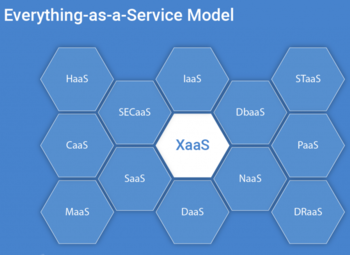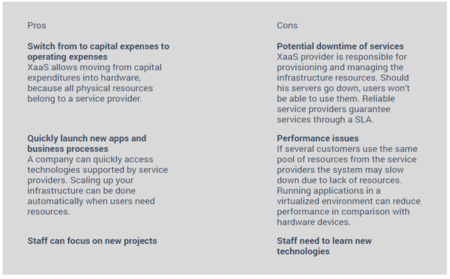XaaS (Everything as a Service)
Everything as a Service aka XaaS is a term for services and applications that users can access on the Internet upon request. XaaS encompasses any computing service that is delivered via the internet and paid for in a flexible consumption model rather than as an upfront purchase or license.
XaaS evolved from the cloud services model. Seeking cheaper, more efficient ways to run IT, CIOs began adopting the cloud for anything from email to CRM, to ITSM and business intelligence visualization, to compute, storage, and even networking, via software-defined networks. XaaS describes on-demand services that achieve scale horizontally across the business. Seventy-one percent of 1,170 IT and line-of-business professionals, from large U.S. companies, surveyed by Deloitte, said that XaaS makes up more than half of their enterprise IT.
Learning from their vendor partners along the way, savvy CIOs began co-opting XaaS best practices as their own blueprint for building and delivering new IT services to their business peers. "Rather than simply using flexible consumption models to cut costs and increase workforce efficiency, many organizations are adopting XaaS to transform digitally and become more agile. Accelerating agility with XaaS."
The XaaS operating model looks different for every company. But it typically involves leveraging agile and/or DevOps principles to deliver technology services more rapidly. This includes a speedy update cycle comprising minimally viable products, automation properties, and design thinking. In XaaS, CIOs may serve act as "cloud brokers," partnering with the business to find the right SaaS or IaaS solution, or cribbing notes from the playbooks of their cloud vendor peers to build something from scratch. Sometimes, XaaS requires an organizational restructuring along service lines. The means may be different, but the desired ends are the same: Speed and agility.[1]
The XaaS Model[2]
XaaS is a conceptual model consisting of all possible services and products that can be provided over networks. At the moment, there is no full implementation of this model. Pushing for XaaS is an ideal benchmark and one of the main strategies for leading global cloud companies such as Microsoft and Google. Below are some practical -aaS cases (apart from SaaS, PaaS, and IaaS) that are gaining popularity.
- Hardware-as-a-Service (HaaS): Managed service providers (MSP) own some hardware and install it on customers’ sites on demand. Customers utilize the hardware in accordance with service level agreements. This pay-as-you-go model is similar to leasing and can be compared to IaaS when computing resources are located at MSP’s site and provided to users as virtual equivalents of physical hardware. The Haas model is especially cost-effective for small or mid-sized businesses.
- Communication-as-a-Service (CaaS): This model includes different communication solutions such as VoIP (voice over IP or Internet telephony), IM (instant messaging), and video conference applications that are hosted in the vendor’s cloud. A company can selectively deploy communication apps that best suit their current needs for a certain period and pay for this usage period only. Such an approach is cost-effective and reduces expenses for short-time communication needs.
- Desktop-as-a-Service (DaaS): Desktops are delivered as virtual services along with the apps needed for use. Thus, a client can work on a personal computer, using the computing capacities of third-party servers (which can be much more powerful than those of a PC). A DaaS provider is typically responsible for storing, securing, and backing up user data, as well as delivering upgrades for all the supported desktop apps.
- Security-as-a-Service (SECaaS): This is the model of outsourced security management. A provider integrates their security services into your company’s infrastructure and, as a rule, delivers them over the Internet. Such services may include anti-virus software, encryption, authentication, intrusion detection solutions, and more.
- Healthcare-as-a-Service (HaaS): With electronic medical records (EMR) and hospital information systems (HIS), the healthcare industry is transforming into Healthcare-as-a-Service. Medical treatment is becoming more data-driven and patient-centric. HaaS creates opportunities for almost all categories of citizens to get qualified medical help. Thanks to the IoT, wearables, and other emerging technologies, the following services are available:
- Online consultations with doctors
- Health monitoring 24/7
- Medicine delivery at your doorstep
- Lab samples collection even at home and delivery of results as soon as they are ready
- Access to your medical records 24/7
- Transportation-as-a-Service (TaaS): Important trends of modern society are mobility and freedom of transportation at different distances. There are numerous apps popping up connected with transport, so a part of this industry is transforming into an -aaS model. TaaS model is not only convenient but also ecologically friendly. The most vivid examples are:
- Carsharing (you can rent a car at any place via a special app and drive anywhere you need, paying for the time you use a car, or for the distance you cover)
- Uber taxi services (you order a taxi via an app, which calculates the cost of the route in advance). Uber is planning to test flying taxis and self-driving planes in the near future.
Pros and Cons of XaaS[3]
XaaS provides numerous advantages to end users and has only one disadvantage: using a cloud service for many years ahead may become more expensive in comparison with a lifetime software program. There are more cons for companies, however, they also have many .. advantages.
XaaS, like a taxi, is not for everyone. Some people don’t believe in drivers, others do not want to overpay, and someone simply likes to drive themselves. Experts recommend that a company store crucial processes locally and locate only non-critical functions in cloud.
See Also
Application Life Cycle Management Platform as a Service (ALM PaaS)
Business Process as a Service (BPaaS)
Platform as a Service (PaaS)
Product-as-a-Service (PaaS)
Software as a Service (SaaS)
Application Platform as a Service (aPaaS)
Infrastructure as a Service (IaaS)
Mobile Platform as a Service (mPaaS)


